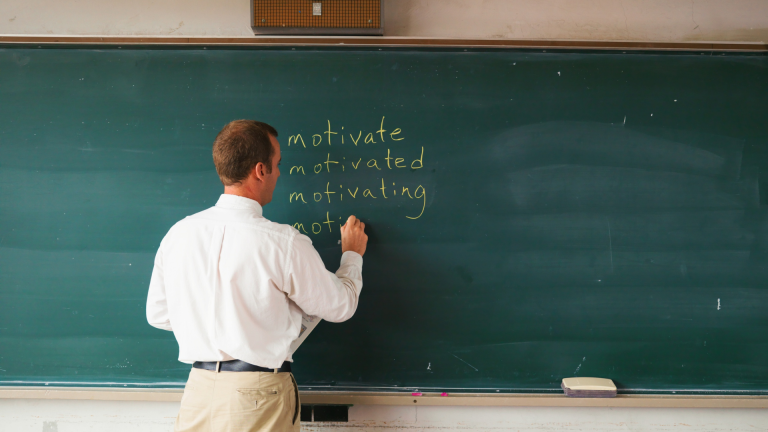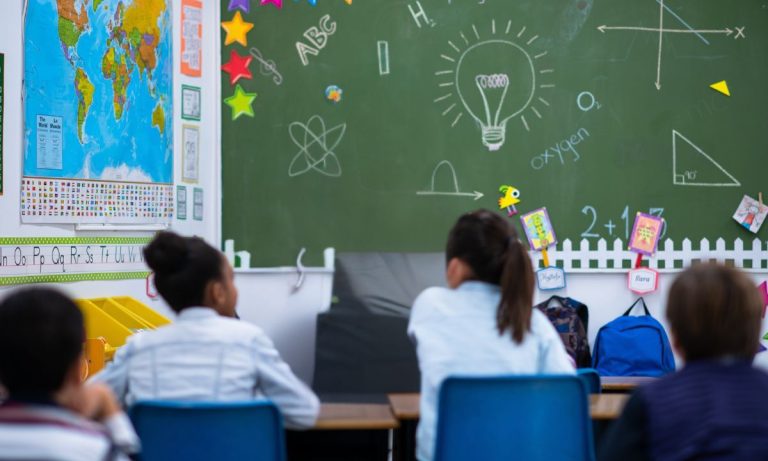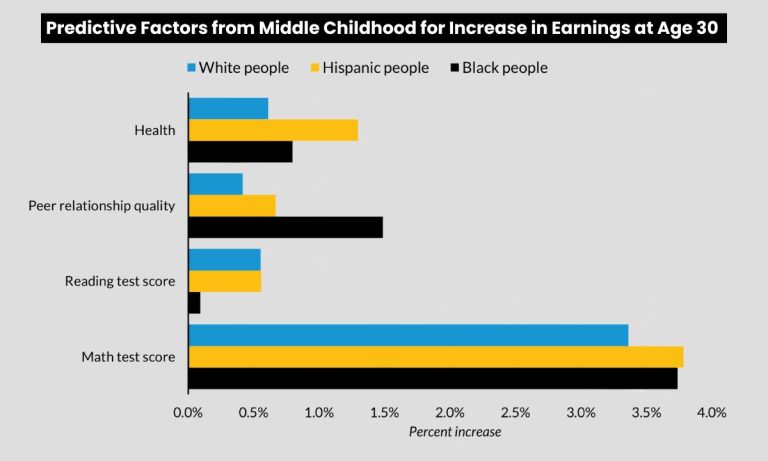Welcome to the first edition of The Learning Curve in 2025! We’re kicking off the year with the latest insights on public education, starting with the January 29 release of the National Assessment of Educational Progress (NAEP) results. These biennial assessments provide a critical look at student achievement across the country.
Explore our Houston ISD-specific NAEP findings, and for a broader perspective, check out Texas 2036’s state-level analysis.
What we’re talking about in public education this month:
- Beyond Graduation: Rethinking readiness and support to help more Houston students succeed in college and careers.
- Achievement Fuels Motivation, Not The Other Way Around: Groundbreaking research shifts the narrative, urging schools to focus on clear instruction to drive student engagement.
- Teacher Absenteeism Hits Crisis Levels Nationwide: How Houston is bucking the trend and what it means for students.
- What’s Behind The U.S. Math Crisis?: A look at widening math gaps and the need to rethink instruction in Houston and beyond.
- America’s Education Crisis: Why structural change is the only path forward.
- Declining Student Achievement Nationwide: Why pandemic recovery efforts in schools may be falling short and what Houston’s focus on fundamentals could teach us.
Less than 20% of Houston Students Earn Living Wages Six Years After Graduation

Photo by Shutterstock, Inc.
New research from Good Reason Houston through the University of Houston Education Research Center (UH ERC) highlights a critical gap: while 70% of Texas jobs will require a postsecondary credential by 2036, only 27% of Houston’s 2012 and 2017 high school graduates attained one. Just 20% of the class of 2017 earned a living wage six years after graduation. A credential significantly boosts earning potential—graduates with a bachelor’s degree were 3.8 times more likely to earn a living wage, and those with a professional certificate were three times more likely. Three key academic experiences—completing Algebra I in 8th grade, meeting 8th grade STAAR reading standards, and taking five or more advanced courses—strongly predict economic success. The findings emphasize the urgent need to expand rigorous coursework and quality instruction to better prepare students for the workforce.
What it means for the city and Houston students
Economic mobility starts with a strong foundation of education and opportunity. Too many Houston students aren’t getting an education that leads to financial stability. Houston students leave school without the skills or credentials to earn a living wage. Addressing this challenge requires a twofold approach: strengthening pre-K-12 education to better prepare students for high-wage careers and tackling systemic barriers—like poverty and access to early learning—that shape long-term success. Houston must invest in high-quality early education, targeted academic interventions, and stronger postsecondary pathways to give every student a real shot at economic independence.
Further Reading:
- Research highlights how socioeconomic disparities contribute to achievement gaps and what strategies can help bridge them.
- A new $11 million initiative aims to investigate how schools can better prepare students for economic success.
- Gain insights from a Substack piece that explores how shifting priorities may be impacting student success.
The Key to Motivating Students—and Maybe Everyone Else Too

Photo from Getty Images
A four-year study of 1,500 elementary students has upended a fundamental assumption in education: Student success fuels motivation, not the other way around. Instead of starting with motivation-building activities, teachers should prioritize clear instruction that helps students experience real success. The evidence is compelling – when students master content through well-structured lessons and concrete examples, their motivation naturally grows alongside their achievements. Think about when you’re being successful at something, doesn’t that motivate you to do it more?
What it means for the city and Houston students
For Houston’s students, this research underscored a simple but powerful idea: success breeds success. In a city committed to educational excellence for all students, we should consider flipping our approach. While motivational strategies like making lessons relatable or offering assignment choices have their place, Houston educators should focus on effective instruction that enables students to experience real achievement—whether mastering multiplication tables or writing their first essay. When students go home feeling accomplished, they return eager to learn more.
Further Reading:
- Explore how lesson clarity directly impacts both student motivation and learning outcomes.
- Learn how small, incremental improvements can lead to better skill development over time.
40% of Chicago Teachers Are Chronically Absent—The Cost and Impact

In Chicago, 40% of teachers missed 10 or more days of school last year, excluding professional development, parental leave, or long-term medical leave. Across Illinois, 34% of teachers faced similar absences. Nationwide, teacher absenteeism remains higher than pre-pandemic levels, costing schools nearly $17 billion on substitutes in 2023, and disrupting student learning—especially for those already behind academically.
What it means for the city and Houston students
Teacher absenteeism is a national issue, but Houston has bucked the trend: HISD recently saw a decline in teacher absences. However, sustaining this trend means tackling teacher stress, workload, and engagement. Houston-area districts must track teacher attendance patterns early and continue supporting teachers while minimizing student disruptions.
Further Reading:
- Discover the key factors that influence teacher attendance and what can be done to improve consistency in the classroom.
Study: Math Scores Impact Adult Earnings More Than Reading or Health

Graph by Urban Institute
A 2024 Urban Institute study reveals that stronger math skills in childhood may impact future earnings more than reading or health. Even modest improvements in math during elementary and middle school can lead to thousands of dollars more in annual income as adults, with girls and Hispanic students seeing some of the largest gains. Yet, U.S. math achievement has hit historic low. The 2022 NAEP saw its largest-ever drop in math scores, and 2024 data confirms a widening gap between high- and low-performing students.
What it means for the city and Houston students
For Houston, the stakes couldn’t be higher. With math-related careers projected to grow by nearly 30% in the next decade, improving math education is essential to securing a brighter future for students and the city’s economy. Improving math instruction—particularly in early education—requires a shift from rote memorization to conceptual understanding while fostering positive attitudes toward math and helping students develop positive attitudes toward math. Last fall, the Texas State Board of Education took up the issue of troubled math performance by approving a new math curriculum aimed at improving student performance.
Further Reading:
- Explore why early math instruction is lacking in preschools and how this impacts students later in their education.
America’s Education Crisis: Structural Change is the Only Path Forward

“According to virtually every available metric, the overall quality of American schools has either declined or remained stagnant since the 1970s.”
A new report from the Hoover Institution’s Education Futures Council declares America’s K-12 education system in crisis. Despite spending 40% more per student than other developed (OECD) nations, U.S. schools rank 34th globally in math, with quality stagnating or declining since the 1970s. The council highlights “fundamental barriers” to student equity and success, including a fragmented system of local boards and agencies that often hinders progress. Students of color and from low-income households are disproportionately affected, and reform efforts have failed to improve outcomes. The report calls for sweeping structural changes, emphasizing that education excellence is vital for national stability and democracy.
What it means for the city and Houston students
Houston has already begun tackling the complex challenges of creating structural change.. Districts are demonstrating how interconnected reforms—system improvements, teacher investments, and stronger curriculum—drive meaningful progress. Achieving educational excellence in Houston will require sustained commitment and overcoming existing roadblocks. Houston’s schools have the opportunity to be a model for bold, transformative change in education.
Further Reading:
- Understand why America’s education system is facing a public emergency and what experts recommend for meaningful reform.
- Gain insight into six decades of school improvement strategies and what lessons still apply today.
Test Scores Declining Across Ages & Demographics

A decade-long decline in American academic achievement has raised alarm, with test scores falling across subjects and age groups, and lower-performing students seeing the steepest drops. Unlike global trends, this issue is uniquely American, with widening achievement gaps in nearly every state. Theories for the decline include relaxed federal accountability policies, the rise of smartphones and social media, and a de-emphasis on basic skills and rigorous expectations in schools. While there’s no single culprit, these factors point to a need for renewed focus on fundamentals like literacy and numeracy to reverse the trend.
What it means for the city and Houston students
The national decline in academic achievement highlights why Houston’s focus on core academic skills is so important. Many public schools—both traditional and charter—are raising standards and emphasizing core skills to help close learning gaps. The integration of the science of learning into teacher professional development is a key part of this effort. While smartphones and social media contribute to the decline, they also prompt local discussions on rethinking technology in schools. By doubling down on strong instruction and re-evaluating the role of technology, Houston has a chance to set an example for educational recovery across the country.
Further Reading:
- Explore three theories on what might be causing the ongoing decline in student achievement.
- See how achievement gaps are growing in your state and what policymakers can do about it.




